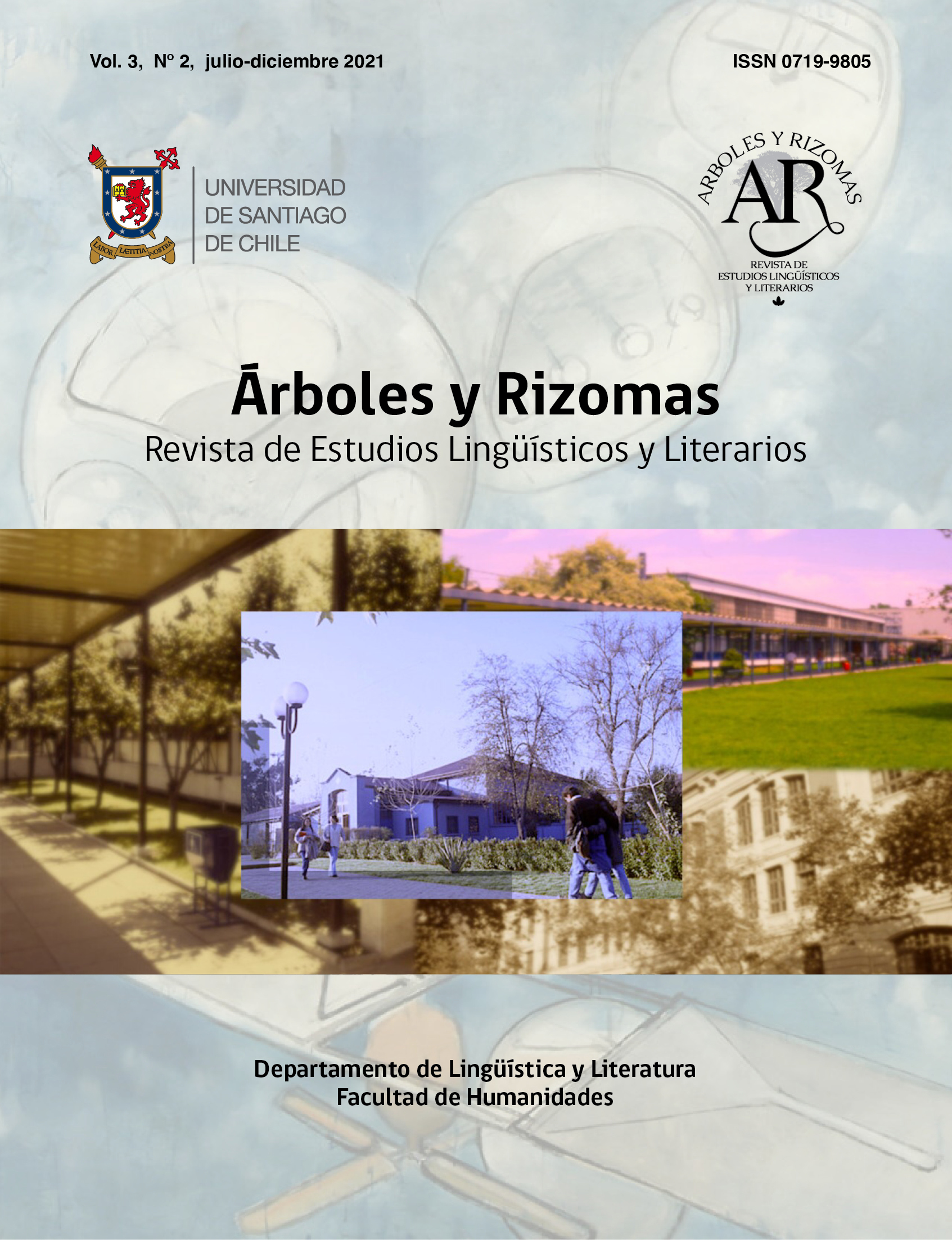“¡Hey! Un patacón ahí” Mobilization of meanings and construction of identities in the Getsemaní neighborhood in Bizarre Foods
DOI:
https://doi.org/10.35588/ayr.v3i2.5125Keywords:
identities, multimodal resources, semiotics, global south, colonialist discoursesAbstract
This essay seeks to establish the way in which the American TV show Bizarre Foods Americas builds up identities and meanings about the Getsemaní neighborhood (Cartagena de Indias, Colombia), during the interaction between an English-speaking 'adventurous cook' and the local people of the neighborhood, through multimodal resources. To describe and interpret the data we resort, on one hand, to virtual ethnography (Domínguez, et.al., 2007; Pauwels, 2012) and, on the other, to concepts related to language and globalization to explain the construction of identities (Blommaert, 2010; PietikÄinen, 2018; Menezes de Souza, 2019; Stroud, 2017). The results show that through a diverse repertoire of semiotic resources used during the program, different local identity traits are established. Results also evidence the perpetuation and legitimization of adverse social phenomena for the local population referred to unequal social relations of power and colonialist discourses.
Downloads
References
Agencia Efe. (2020, enero). La gentrificación amenaza a Getsemaní, uno de los barrios más «cool» del mundo. QUÉPASA. Recuperado de https://quepasamedia.com/noticias/mundo/sudamerica/la-gentrificacion-amenaza-a-getsemani-uno-de-los-barrios-mas-cool-del/
De Anglería, P. (1944). Décadas del nuevo mundo. Buenos Aires: Editorial Bajel.
Barragán, M. (2017, julio). Gentrificación: Fronteras que amplían la desigualdad. DEJUSTICIA. Recuperado de https://www.dejusticia.org/column/gentrificacion-fronteras-que-amplian-la-desigualdad/
Bernal, C. & Orjuela, G. (1992). Prospección arqueológica en el municipio de Turbana, departamento de Bolívar. Boletín de Arqueología. 3(7), 7-79.
Blommaert, J. (2010). The sociolinguistics of globalization. Cambridge: Cambridge University Press.
Domínguez, D., Beaulieu, A., Estalella, A., Gómez Cruz, E., Schnettler, B., Read, R. (2007). Virtual Ethnography. Forum Qualitative Sozialforschung / Forum: Qualitative Social Research, 8(3), 1-5. http://nbn-resolving.de/urn:nbn:de:0114-fqs0703E19
Dussan de Reichel-Dolmatoff, A. (1954). Crespo un nuevo complejo arqueológico en el norte de Colombia. Revista Colombiana de Antropología. 1, 173-178.
Forbes Staff. (2020, enero). Getsemaní, el barrio de Cartagena entre los más ‘cool’ del mundo. FORBES COLOMBIA. Recuperado de https://forbes.co/2020/01/03/forbes-life/getsemani-el-barrio-de-cartagena-entre-los-mas-cool-del-mundo/
Guilherme, M. (2018). ‘Glocal Languages’: The ‘Globalness’ and the ‘Localness’ in World Languages. In S. Coffey & U. Wingate (eds.) New Directions for Research in Foreign Language Education. pp. 79–96. New York: Routledge.
Heller, M., PietikÄinen, S., & Pujoar, J. (2018). Critical sociolinguistic research methods: studying language issues that matter. New York: Routledge.
Kelly, C. (2014). Bizarre Foods: White Privilege and the Neocolonial Palate. Scholarship and Professional Work - Communication. 97, 1-26.
Khubchandani, L. (1988). Language in a Plural Society. Shimla: Indian Institute of Advanced Study.
Khubchandani, L. (1997). Revisualizing Boundaries: A Plurilinguistic Ethos. New Delhi: Sage Publications.
Lemaitre, E. (1983). Historia general de Cartagena, la independencia. Bogotá: Banco de la República.
Lozano, M., Jiménez-Caicedo, J. & Abraham, L. (2020). Linguistic Landscape projects in language teaching: opportunities for critical language learning beyond the classroom. En Malinowski, D.; H. M. Maxim & S. Dubreil (Eds.), Language Teaching in the Linguistic Landscape: Mobilizing Pedagogy in Public Space. Heidelberg: Springer, pp. 17-42.
Marino, C. (productor). (2012-2014). Bizarre Foods Americas [serie de televisión]. U.S: Tremendous Entertainment.
Melo, J. y Langebaek, C. (1996). Historia de Colombia: el establecimiento de la dominación española. Bogotá: Presidencia de la República.
Menezes de Souza, L-M. T. (2019). Glocal languages, Coloniality and Globalization from below. In, M. Guilherme and L-M T. Menezes de Souza (eds). Glocal Languages and Critical Intercultural Awareness. The South Answers back. Pp. 17-41. New York: Routledge.
Menezes de Souza, L-M. T. & Guilherme, M. (2019). Conclusion: Towards globalization from below. In M. Guilherme and L-M. T. Menezes de Souza (eds). Glocal Languages and Critical Intercultural Awareness. The South Answers back. Pp. 228-241. New York: Routledge.
Pauwels, L. (2012). A multimodal framework for analyzing websites as cultural expressions. Journal of Computer-Mediated Communication, 17, 247-265.
Pavlenko, A. (2006). Bilingual selves. In A. Pavlenko (ed.). Bilingual minds: Emotional experiences, expression, and representation, pp. 1-33. Cambridge: Cambridge U niversity Press.
PietikÄinen, S. (2018). Investing in indigenous multilingualism in the Arctic. Language and Communication, 61 (Part B, September), 184-195.
https://doi.org/10.1016/j.langcom.2018.05.001
Pineda, R. (1988). Los Caribes. En Historia de Colombia-La Colombia más Antigua, Bogotá: Enciclopedia Salvar Editores Colombiana S.A.
Posso Jiménez, L. (2013). Getsemaní: de barrio periférico a núcleo de la escena cultural contemporánea. Visitas al patio, 7, 87-104.
https://doi.org/10.32997/2027-0585-vol.0-num.7-2013-1691
Redacción Arcadia Bogotá (2013, febrero). La Gentrificación en Cartagena: El desalojo neoliberal. SEMANA. Recuperado de https://www.semana.com/impresa/antropologia/articulo/el-desalojo-neoliberal/31176/
Reichel-Dolmatoff, G. (1955). Excavaciones en los conchales de la Costa de Barlovento. Revista Colombiana de Antropología. 4, 248-272.
Reichel-Dolmatoff, G. (1986). Introducción a la Arqueología de Colombia, un texto introductorio. Bogotá: Fundación Expedición Botánica.
Reichel-Dolmatoff, G. (1990). Sierra Nevada: cambio cultural. Caribe Colombia. Bogotá, Colombia: Financiera Energética Nacional.
Santos, B. de S. (2010). A Non- Occidental West: Learned ignorance and an ecology of knowledges. Theory Culture Society, 26, 103–123.
Schroeder, J. (1998). Consuming Representation: A Visual Approach to Consumer Research. In Barbara B Stern (Ed.). Representing Consumers: Voices, Views and Visions, pp. 193-230. London: Routledge.
Stroud, C. (2017). A postscript on the postracial. In C. Kerfoot and K. Hyltenstam (eds). 'Entangled Discourses: South-North Orders of Visibility', pp. 230-237. New York: Routledge.
Téwodros, W. (2019). Exotica Africana: interrogating African otherness in Bizarre Foods with Andrew Zimmern. Popular Communication: The International Journal of Media and Culture. Recuperado de:
https://doi.org/10.1080/15405702.2019.1637524.
Williams, R. (1987). Drama from Ibsen to Brecht. London: The Hogarth Press.






